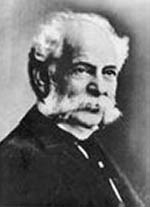 [div class=attrib]From Anthropology in Practice:[end-div]
[div class=attrib]From Anthropology in Practice:[end-div]
Do me a favor: Go open your refrigerator and look at the labels on your condiments. Alternatively, if you’re at work, open your drawer and flip through your stash of condiment packets. (Don’t look at me like that. I know you have a stash. Or you know where to find one. It’s practically Office Survival 101.) Go on. I’ll wait.
So tell me, what brands are hanging out in your fridge? (Or drawer?) Hellmann’s? French’s? Heinz? Even if you aren’t a slave to brand names and you typically buy whatever is on sale or the local supermarket brand, if you’ve ever eaten out or purchased a meal to-go that required condiments, you’ve likely been exposed to one of these brands for mayonnaise, mustard, or ketchup. And given the broad reach of Heinz, I’d be surprised if the company didn’t get a mention. So what are the origins of Heinz—the man and the brand? Why do we adorn our hamburgers and hotdogs with his products over others? It boils down to trust—carefully crafted trust, which obscures the image of Heinz as a food corporation and highlights a sense of quality, home-made goods.
Henry Heinz was born in 1844 to German immigrant parents near Pittsburgh, Pennsylvania. His father John owned a brickyard in Sharpsburg, and his mother Anna was a homemaker with a talent for gardening. Henry assisted both of them—in the brickyard before and after school, and in the garden when time permitted. He also sold surplus produce to local grocers. Henry proved to have quite a green thumb himself and at the age of twelve, he had his own plot, a horse, a cart, and a list of customers.
Henry’s gardening proficiency was in keeping with the times—most households were growing or otherwise making their own foods at home in the early nineteenth century, space permitting. The market for processed food was hampered by distrust in the quality offered:
Food quality and safety were growing concerns in the mid nineteenth-century cities. These issues were not new. Various local laws had mandated inspection of meat and flour exports since the colonial period. Other ordinances had regulated bread prices and ingredients, banning adulterants, such as chalk and ground beans. But as urban areas and the sources of food supplying these areas expanded, older controls weakened. Public anxiety about contaminated food, including milk, meat, eggs, and butter mounted. So, too, did worries about adulterated chocolate, sugar, vinegar, molasses, and other foods.
Contaminants included lead (in peppers and mustard) and ground stone (in flour and sugar). So it’s not surprising that people were hesitant about purchasing pre-packaged products. However, American society was on the brink of a social change that would make people more receptive to processed foods: industrialization was accelerating. As a result, an increase in urbanization reduced the amount of space available for gardens and livestock, incomes rose so that more people could afford prepared foods, and women’s roles shifted to allow for wage labor. In fact, between 1859 and 1899, the output of the food processing industry expanded 1500%, and by 1900, manufactured food comprised about a third of commodities produced in the US.
So what led the way for this adoption of packaged foods? Believe it or not, horseradish.
Horseradish was particularly popular among English and German immigrant communities. It was used to flavor potatoes, cabbage, bread, meats, and fish—and some people even attributed medicinal properties to the condiment. It was also extremely time consuming to make: the root had to be grated, packed in vinegar and spices, and sealed in jars or pots. The potential market for prepared horseradish existed, but customers were suspicious of the contents of the green and brown glass bottles that served as packaging. Turnip and wood-fibers were popular fillers, and the opaque coloring of the bottles made it hard to judge the caliber of the contents.
Heinz understood this—and saw the potential for selling consumers, especially women—something that they desperately wanted: time. In his teens, he began to bottle horseradish using his mother’s recipe—without fillers—in clear glass, and sold his products to local grocers and hotel owners. He emphasized the purity of his product and noted he had nothing to hide because he used clear glass so you could view the contents of his product. His strategy worked: By 1861, he was growing three and a half acres of horseradish to meet demand, and had made $2400.00 by year’s end (roughly $93,000.00 in 2012).
[div class=attrib]Read the entire article after the jump.[end-div]
[div class=attrib]Image: Henry J. Heinz (1844-1919). Courtesy of Wikipedia.[end-div]
